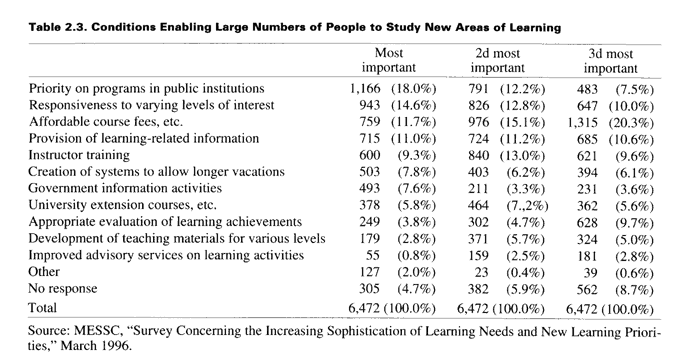| Home > Policy > White Paper, Notice, Announcement > White Paper > JAPANESE GOVERNMENT POLICIES IN EDUCATION, SCIENCE, SPORTS AND CULTURE 1996 > Priorities and Prospects for a Lifelong Learning Society Chapter 2 Section 2 3 | ||
Instructors can be broadly divided into those who provide guidance for individual learning activities and those who support learning activities through such roles as the promotion of learning-group formation and the proposal and planning of learning activities.
Traditionally, instructors have been trained by various institutions and organizations. According to the "Social Education Survey," boards of education provided 2,585 instructor training courses for public employees (social education directors and so on) in fiscal 1992. A total of 90,288 people participated in these programs. Another 59,570 people attended 2,675 programs for facility employees (citizens' public hall officers and so on). There were also 7,123 programs for volunteer instructors, such as those working for nongovernmental organizations. Enrollment totaled 537,705.
Social education directors, museum curators, and librarians also play an important role in learning activities. In fiscal 1991 training courses in these categories qualified 3,602, 6,346, and 4,742 people, respectively. Yet not everyone obtaining qualifications through such programs takes up employment in those fields. A fiscal 1991 survey on the career paths of people obtaining qualifications at the university level shows that the majority did not take up positions related to their qualifications. Some qualified people, however, work as volunteers in social education facilities and elsewhere.
Participants in learning activities are becoming increasingly diverse in age, educational background, and other aspects. Instructors are therefore likely to be required to direct activities that they cannot handle adequately by using skills suited to the instruction of relatively homogeneous learner groups. There is also evidence that instructor training and pooling are still inadequate in terms of coping with social changes, such as internationalization. In a MESSC survey 9.3% of respondents cited instructor training as the most important requirement for learning activities in new areas, while 13.0% saw it as the second most important factor ( Table 2.3 ).
The increasing diversity and sophistication of learning activities are reflected in the need for various types of assistance for the instructors who propose and plan programs. Concern has been expressed over the difficulty of providing suitable assistance.
Those involved in the monitoring of learning needs have to obtain information about facilities, instructors, learning programs, and advice from specialized instructors so that such information and advice can be applied to the training and pooling of instructors capable of coordinating the development of learning activities at a certain level. Some prefectural and municipal governments are already training such people, whose job titles include "lifelong learning facilitator."
As discussed in section 3, there is growing interest in volunteer activities. It should be possible to apply knowledge and skills gained through learning activities to the training and pooling of instructors.

| Back to Top | MEXT HOME |